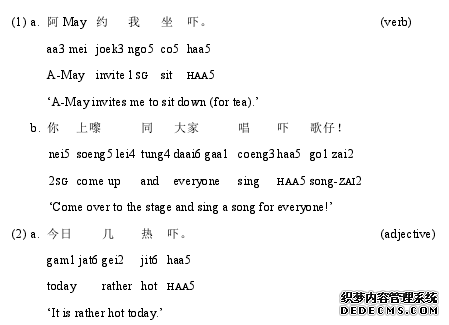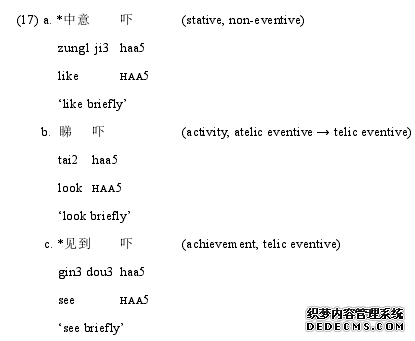CHAPTER ONE INTRODUCTION
1.1 Haa5 in Cantonese
Haa5 is an affix attached to verbal and adjectival elements in Hong Kong and Guangzhou Cantonese. It occurs frequently in casual occasions like daily conversations, street interviews, or personal comments rather than formal occasions like official announcements, business communication and important rituals.


Examples above show that haa5 goes after a verbal element like co5 ‘sit’ in (1a) and coeng3 ‘sing’ in (1b), as well as an adjectival element jit6 ‘hot’ in (2a) and mun6 ‘boring’(2b). It would be of interest to look closer into haa5 to study its distributions, grammatical properties, meaning and function, since the affix haa5 is widely used in daily life but its core properties are not widely known.
..........................
1.2 Previous Views on Haa5
1.2.1 Haa5 in Verbal Contexts
Scholars generally agree that the original reading of haa5 is “a stroke” (Peng Xiaochuan 2000, 2010, Wang Hongmei et al. 2007, Choo Yuen 2010, among many others). Haa5 originated as a classifier meaning ‘once’ in V-jat1-haa5 ‘V-once’ constructions, like zong6 jat1 haa5 go3 zung1 ‘hit the bell once’ (3a). As time went by, the numeral expression jat1 was omitted, and thus forming V-haa5 constructions (ibid), as in zong6 haa5 go3 zung1 ‘hit the bell once’ (3b).
Consider (5a), the action of gam6 ‘pressing’ lasts just for a very short time. The amount of time is factually small, which does not involve the speaker’s judgement. In contrast, the action of zyu6 ‘live’ (5b) obviously last for a long time. The speaker uses haa5 to convey his/her own judgement, attitude and feeling that the unfavourable situation of living in a small apartment is temporary. When the hearer becomes richer, (s)he will move to a better house. Haa5 expresses the speaker’s intention to ease the frustration of the hearer.
Derived out of its original meaning, haa5 has several derived readings in verbal contexts.
First, haa5 represents briefness in time and effort in completing an action (Li Xinkui 1995, among others). Therefore, short-term actions like haau1 ‘knocking on the door’ (6a) and man6 ‘asking’ (6b) can be modified by haa5 (Gao Huanian 1980, Cheung Hung-Nin 2007, Rao Bingcai et al. 2009, Peng 2010, Tang Sze-Wing 2015b, among others).
.........................
CHAPTER TWO HAA5 IN VERBAL CONTEXTS
2.1 The Meaning of Haa5
2.1.1 Previous Views on the Meaning of Haa5
Generally speaking, the study holds similar views on the readings of haa5. Its original meaning is ‘a stroke, a bit, or a tiny amount’, and it has the following derived readings:
(1) briefness in time and effort in completing an action;
(2) short-term actions;
(3) a tentative aspectual marker;
(4) to express that the action is casual or performed in a casual manner; and
(5) to make the request milder.
However, a different proposal for understanding these readings is suggested. I propose that the derived readings are not the real meaning of haa5. The real meaning of haa5 has always been ‘a stroke, a bit, or a tiny amount’, and the derived readings are extensions from the original meaning of haa5. Actually, the derived readings are brought about by the context in which haa5 occurs.
...........................
2.2 Distributions of Haa5 in Verbal Contexts
2.2.1 Verb Types and Haa5
I will first investigate the verb types selected by verbal-haa5. Stative verbs such as zung1 ji3 ‘like’ (17a) does not co-occur with haa5, because stative verbs are non-eventive. Haa5 selects eventive verbs only. Achievement verbs like gin3 dou3 ‘see’ (17c) and accomplishment verbs like se2 jyun4 ‘finish writing’ (17d) cannot be modified by haa5 either, where both types of verbs are telic. Haa5 follows activity verbs only, like tai2 ‘look’ (17b), since activity verbs are atelic. In the case of (17b), the event of tai2 ‘look’ has no specific starting or ending point. By adding haa5 to form tai2 haa5 ‘look briefly’, the time span of the activity is set, and the action of looking will last for just a short while.


My observation is that haa5 goes after activity verbs, delimits an event, and turns atelic eventive activity verbs into telic eventive ones.
..........................
CHAPTER THREE HAA5 IN ADJECTIVAL CONTEXTS ............................ 21
3.1 The Distribution of Haa5 ................................... 21
3.2 Minor Adjustments of Degree ......................... 22
3.3 Semantic Restrictions on Haa5 in Adjectival Contexts ............................... 25
CHAPTER FOUR HAA5 IN VERBAL AND ADJECTIVAL CONTEXTS: A UNIFIED ACCOUNT ................. 31
4.1 Domain of Haa5 ................. 31
4.2 Syntactic Analysis: Verbal-haa5 ...................... 33
CHAPTER FIVE CONCLUSION ........................ 49
5.1 Summary of Major Findings .......................... 49
5.2 Limitations ............................... 50
CHAPTER FOUR HAA5 IN VERBAL AND ADJECTIVAL CONTEXTS: A UNIFIED ACCOUNT
4.1 Domain of Haa5
On the basis of discussions in Chapter 2 and 3, haa5 in both domains will be compared and contrasted. Some important facts (b-d) are summarized from observations in previous chapters, based on the prerequisite (a):
(a) Events in verbal contexts and degree in adjectival contexts are comparable on a scale basis.
(b) Haa5 expresses the briefness of an event and the minor adjustment of degree.
(c) Haa5 can only be attached to activity verbs and gradable adjectives.
(d) The attachment of haa5 turns atelic eventive verbs into telic ones and adjusts slightly the degree of adjectives with moderate degree modifiers.
Visualized in a chart, the domain of haa5 becomes clearer. The distributions of haa5 in both verbal and adjectival contexts are restricted.
As chart (36) shows, haa5 cannot modify non-eventive or non-gradable grammar items: stative verbs and non-gradable adjectives. Haa5 never co-occurs with grammar items on the top: accomplishment and achievement verbs in the verbal context, or gradable adjectives with a polarity degree modifier in the adjectival context because they represent the completion of events and the upper bound of the degree respectively. Nor does haa5 go after items at the bottom: inchoative verbs in the verbal context or gradable adjectives with a polarity degree modifier in the adjectival context, as they denote the starting point of events and the lower bound of the degree in their respective terms.
..........................
CHAPTER FIVE CONCLUSION
5.1 Summary of Major Findings
To conclude, all uses of haa5 stem from its original meaning: ‘a stroke, a bit, or a tiny amount’. The two major functions of haa5 are also concerned with its original meaning: (1) to show briefness in duration or effort of an action and (2) to adjust the degree moderately. The tiny amount reading of haa5 also enables it to modify events in sequence.
The distributions of haa5 in verbal and adjectival contexts share two similarities in terms of the phrases haa5 selects and the semantic requirements of haa5. First, haa5 selects atelic eventive verbs with an aspectual marker or a modality marker, as well as gradable adjectives with a moderate degree modifier. Haa5 never goes with a bare lexical item. Second, haa5 cannot co-occur with eventive verbs with starting/ending points, or gradable adjectives with upper/lower bounds. When reflected on a diagram, the alignment of the distributions of haa5 in both contexts is clearly shown: haa5 goes with lexical categories whose semantics are around the middle of the event progress/degree.#p#分页标题#e#
As for the function of haa5, it is to convey the speaker’s subjective evaluation of an event or degree. Acceptability of the same sentence containing haa5 varies depending on the distinctive conversational contexts. Although previous views on the derived readings of verbal and adjectival haa5 are acceptable, I argue that these meanings are produced by the context rather than by haa5 itself, where the speaker expresses his/her subjectivity with the use of haa5.
reference(omitted)

